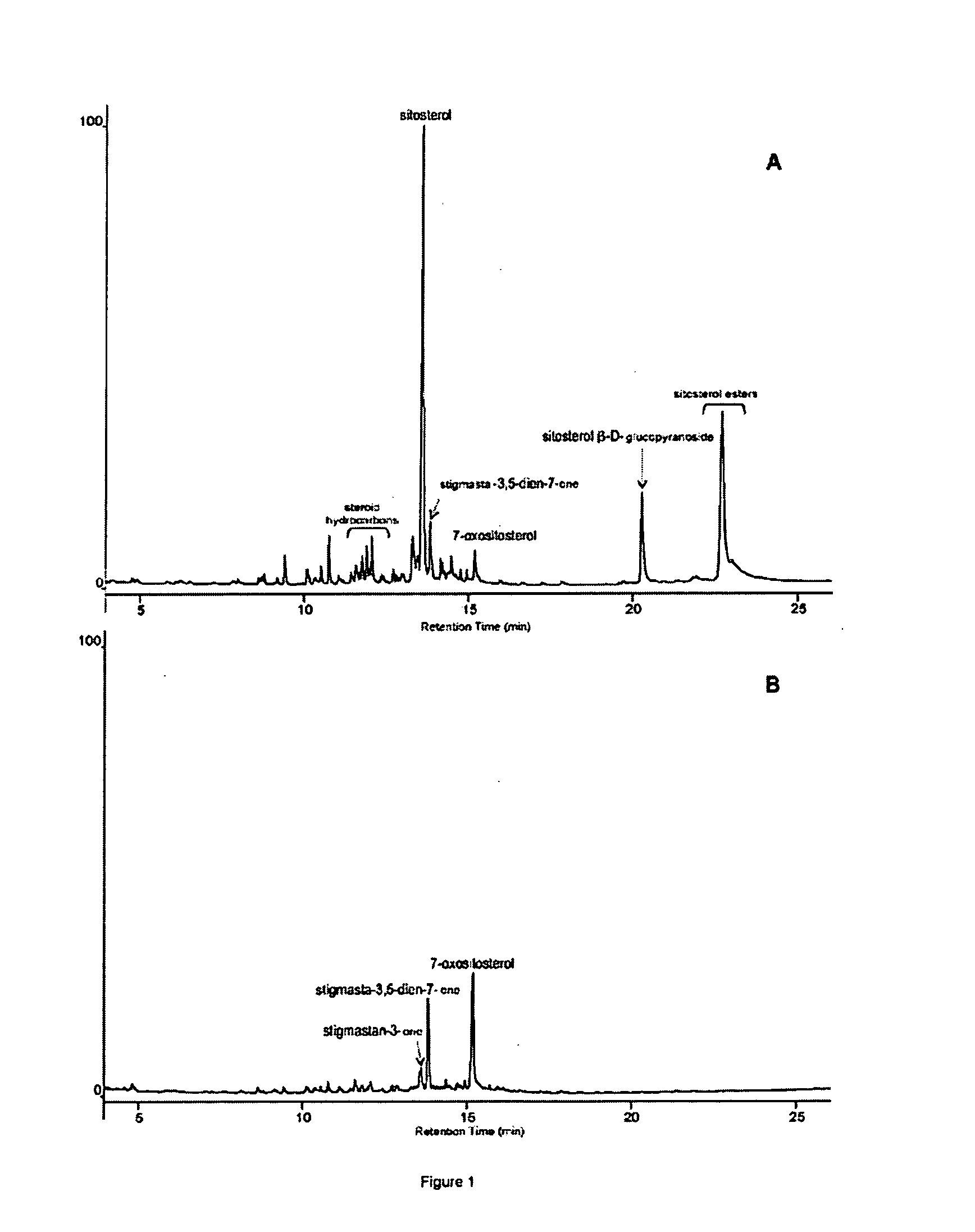Mediator-Enzyme System for Controlling Pitch Deposits in Pulp and Paper Production
a technology of microorganisms and enzymes, applied can solve the problems of serious losses in the industrial sector, new problems in pulp manufacturing and bleaching, and insufficient methods to eliminate pitch deposits in paper pulp, etc., to reduce the problem of pitch deposits, reduce the cost involved, and improve the quality of the final product.
- Summary
- Abstract
- Description
- Claims
- Application Information
AI Technical Summary
Benefits of technology
Problems solved by technology
Method used
Image
Examples
example 1
Treatment of Eucalyptus Kraft Pulp with Laccase (from Pycnoporus cinnabarinus) and HBT (1-hydroxybenzotriazole)
[0039]To check the effectiveness of the treatment of the eucalyptus pulp with the laccase-mediator system in the elimination of the compounds responsible for the formation of pitch deposits, eucalyptus (Eucalyptus globulus) kraft pulp is used that contains free sterols, sterol esters and sterol glucosides.
[0040]The laccase used in this and in the following examples was obtained in 1 m3 digesters with cultures from a Pycnoporus cinnabarinus strain that produces laccase, such as CECT 24448 (=IJFM A720), cultivated according to that described by Herpoël et al. (Herpoël et al. 2000, Selection of Pycnoporus cinnabarinus strain for laccase production, FEM Microbiol. Lett. 183: 301-306). A unit of laccase activity was defined as the quantity of enzyme that oxidizes one μmol / min of 2,2′-azino-bis(3-ethylbenzthiazoline-6-sulphonic acid (ABTS) to the corresponding cationic radical, a...
example 2
Treatment of Picea Thermomechanical Pulp with Laccase (from Pycnoporus cinnabarinus) and HBT (1-hydroxybenzotriazole)
[0045]To check the effectiveness of the treatment with laccase-mediator for the elimination of the compounds responsible for the formation of pitch deposits in the manufacturing of Picea pulp, treatment was carried out on Picea abies thermomechanical pulp, with a high content in triglicerides, sterol esters, resin acids and fatty acids.
[0046]10 g of raw Picea pulp (obtained after the first refining) with a consistence of 10% was treated for 2 hours at 50° C. with 20 U of laccase / g of pulp in the presence of the mediator HBT at 1.5% (w / w) using 50 mM tartrate buffer, pH 4, under a humid current of oxygen. Simultaneously, controls were carried out without enzymes in the same conditions. The pulp treated enzymatically as well as the controls were dried and extracted in Soxhlet with acetone for 8 hours. The extractable fraction was dried and the compounds soluble in chlor...
example 3
Treatment of Linen Soda-Anthraquinone Pulp with Laccase (from Pycnoporus cinnabarinus) and HBT (1-hydroxybenzotriazole)
[0048]To check the effectiveness of the treatment of the linen pulp with the laccase-mediator system in the elimination of the compounds responsible for the formation of pitch deposits, soda-anthraquinone pulp of Linum usitatissimum that contains fatty alcohols, free sterols, and sterol glucosides was used.
[0049]40 g of raw linen pulp (kappa index 11) was treated at 3% consistence for 24 hours at 30° C. with 20 U of laccase / g of pulp in the presence of the mediator HBT at 3% (w / w) in 50 mM tartrate buffer, pH 4, and in the presence of Tween 80 at 0.05% in a reactor with pressurised oxygen (6 bar). The pulps treated enzymatically, as well as the corresponding controls were dried and extracted in Soxhlet with acetone for 8 hours. The extractable fraction was dried and the compounds soluble in chloroform were analysed and quantified by gas chromatography and gas chroma...
PUM
| Property | Measurement | Unit |
|---|---|---|
| Fraction | aaaaa | aaaaa |
| Fraction | aaaaa | aaaaa |
| Fraction | aaaaa | aaaaa |
Abstract
Description
Claims
Application Information
 Login to View More
Login to View More - R&D
- Intellectual Property
- Life Sciences
- Materials
- Tech Scout
- Unparalleled Data Quality
- Higher Quality Content
- 60% Fewer Hallucinations
Browse by: Latest US Patents, China's latest patents, Technical Efficacy Thesaurus, Application Domain, Technology Topic, Popular Technical Reports.
© 2025 PatSnap. All rights reserved.Legal|Privacy policy|Modern Slavery Act Transparency Statement|Sitemap|About US| Contact US: help@patsnap.com



